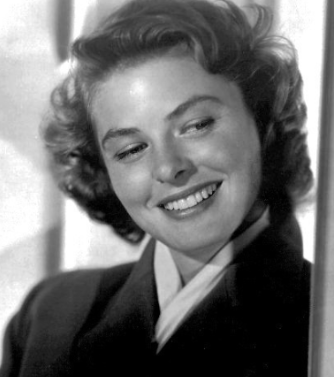 Is there a more radiant screen smile than Ingrid Bergman’s? It lit up the scenes she appeared in, and it is infectious even now when you watch her movies. And what a diverse bunch of films she made – something that’s obvious from the retrospective that the Glasgow Film Festival has put together for this, her centenary year.
Is there a more radiant screen smile than Ingrid Bergman’s? It lit up the scenes she appeared in, and it is infectious even now when you watch her movies. And what a diverse bunch of films she made – something that’s obvious from the retrospective that the Glasgow Film Festival has put together for this, her centenary year.
Bergman was like a breath of fresh air when she arrived in Hollywood, already a successful actress back home in Sweden. Her natural beauty and the air of vitality and wholesomeness she exuded were in contrast to the heavily made-up glamour pusses who populated Hollywood studios in the early 1940s when  her career took off. Audiences loved her in such hits as Casablanca (1942), Gaslight (1944), The Bells of St Mary’s (1945) and Notorious (1946). Her short cropped, curly hair in For Whom the Bell Tolls (1943) launched a trend, and her androgynous appearance in that film was ahead of its time.
her career took off. Audiences loved her in such hits as Casablanca (1942), Gaslight (1944), The Bells of St Mary’s (1945) and Notorious (1946). Her short cropped, curly hair in For Whom the Bell Tolls (1943) launched a trend, and her androgynous appearance in that film was ahead of its time.
She was also somewhat ahead of her time in her determination to be the master of her own career path, rather than relying on others or waiting to be offered parts. When, in the late 1940s, she saw Rome, Open City she decided to write to its director, Roberto Rossellini, in Italy and tell him that she would like to be considered for a role in one of his films. He offered her a part and she went to Italy to work with him.
They fell in love and, not yet divorced from her husband back in America, Bergman bore him a son – and went on to have more children with him (among them the future model/actress Isabella Rossellini). They were married
by then but the relationship had been an international scandal, with Hollywood horrified by Bergman’s behaviour and the press outraged by it. Even Congress weighed in; she was denounced there as “Hollywood’s apostle of degradation”.
But she went on to win her second Best Actress Oscar (the first was for her brilliant portrayal of a young woman  being driven to the brink of madness in Gaslight) for her “come-back” performance in the title role of Anastasia
being driven to the brink of madness in Gaslight) for her “come-back” performance in the title role of Anastasia
(1956), an Oscar that was widely interpreted as evidence of Hollywood forgiving her for her “sins”. In 1974, she won her final Oscar, the Best Supporting Actress statuette, for her turn as the apparently simple Swedish nanny in Murder On the Orient Express. By that time she had been diagnosed with breast cancer, which would kill her eight years – and several more acclaimed performances – later.
* The Glasgow Film Festival runs until March 1


I recall reading in Goldie’s Hawn’s Memoir: A Lotus Grows in the Mud that she worked with Ingrid on a film (I forget which one). Goldie commented on how Ingrid kept to herself. Only coming out of her trailer when it was time for her to do a scene. Goldie said there was something about Ingrid, like she had been beaten down by the Hollywood Machine.
Thanks for your comment. The film must have been Cactus Flower (1969), with Walter Matthau. I don’t think Ingrid had made a movie in Hollywood since before the big scandal, when Hollywood vilified her, so maybe she wasn’t very comfortable being back – or very trusting of Hollywood relationships.
I don’t think I would be, if what happened to her, happened to me. Poor woman. 😦
Hi Alison, I happened upon this site today and it made me think of you.
http://glamourdaze.com/
Hello! How lovely of you – thanks so much. Looks like a site to lose a few hours in!